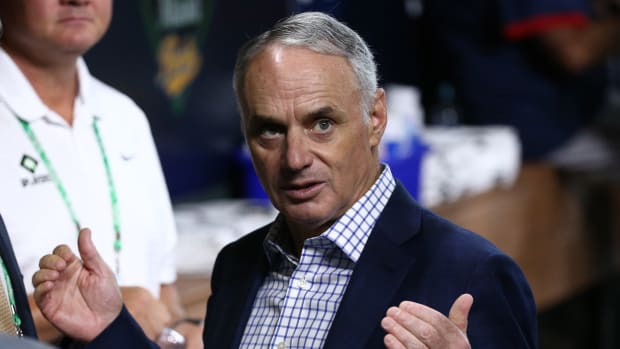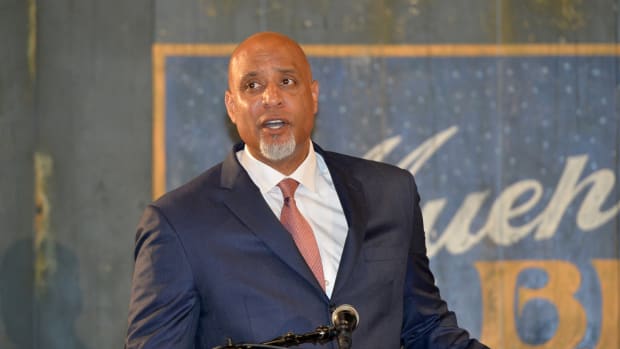MLB Implements Lockout; What It Means And When It Might End
ARLINGTON, Texas — The Collective Bargaining Agreement between Major League Baseball (MLB) and the Players Association (MLBPA) expired at 11:59 p.m. EST on Wednesday. Four minutes later, MLB commissioner Rob Manfred issued "A letter to baseball fans", which formerly announced a new agreement had not been made before the CBA expired, forcing the owners to lock out the players.
It is baseball's ninth work stoppage, and the first the sport has seen in 26 years. For those who may not remember, this is when the players went on strike in the middle of the 1994 season. The work stoppage resulted in the cancellation of the remainder of the season, including the entire postseason and World Series. The strike lasted 232 days—the longest in North American sports, until the National Hockey League's 2004-05 lockout—and did not end until the day before the 1995 season was scheduled to begin.
Even though MLB is second in the world to only the National Football League in terms of revenue, the 1994-95 strike has forever shaken the game of baseball and its popularity. After months of negotiating, it was all but guaranteed another work stoppage was on the horizon when the most recent CBA expired.
Now, as we wait for MLB and the MLBPA to settle their differences and strike an agreement before threatening the loss of any games in 2022, let's take a look at what the current lockout means, its impact and when it may end.
Why a Lockout? Couldn't They Just Keep Negotiating?
Yes. The owners don't have to lock the players out. They could have kept negotiating without a CBA in place, allowing the free agent market and other Major League business to carry on as usual.
However, that's what happened in 1994. The owners and players continued negotiating beyond the expiration of the CBA on Dec. 31, 1993, and those talks—that mainly revolved around the proposed implementation of a salary cap—went along into the season. However, the two sides remained far apart, as the MLBPA has long opposed anything that resembles a salary cap. In turn, the players eventually threatened the owners with a strike. The rest is history.
This time around, MLB is doing everything they can to avoid a repeat of 1994-95. A lockout prevents the players from threatening with a strike. In fact, Manfred views this as a defensive measure, and that "an offseason lockout is the best mechanism to protect the 2022 season".

What Happens During The Lockout?
Regarding Major League activity? Absolutely nothing.
Free agents cannot sign with clubs. Teams cannot trade players on the 40-man roster. Players cannot use team facilities. The Winter Meetings, which were scheduled to begin on Sunday in Orlando, are canceled. The Rule 5 draft is canceled (for now).
In addition, employees of MLB and its 30 clubs are not permitted to communicate with players on the 40-man roster or big-league free agents. After all the handshaking and smiles from the four press conferences in Arlington on Wednesday, Texas Rangers manager Chris Woodward is not permitted to talk with or about any of the new toys he received for Christmas.
Everything in terms of Major League business is frozen. The Hot Stove, which had been scorching hot over the past several days with a flurry of free-agent transactions, is now ice cold. In fact, MLB has even changed the content displayed on their website, which includes the removal of player headshots. This is the first work stoppage baseball has seen in over a quarter century, and technology has changed quite a bit over that time.
What can happen is anything related to the minor leagues. MLB employees can still talk to or about minor league players, and those players are still permitted to use their respective club's facilities. The minor league portion of the Rule 5 draft is still scheduled to take place next week. So, for however long the lockout lasts, teams will get the chance to take a closer look at their farm systems.
And, of course, MLB and the MLBPA can continue negotiating. As long as the two sides are talking, there is hope for a full 162-game season.
How Did We Get Here?
The end of 26 years of labor peace comes to an end with little surprise around the industry. The two sides have been at odds with each other for quite a while, especially on the players' side. They haven't liked how the past two CBAs have gone down, and now they are fighting for change.
In addition, the discord between the two sides was on full display in May and June of 2020, where they attempted to negotiate a restart of the regular season after the COVID-19 pandemic derailed spring training and put the season on an indefinite hold. The two sides were unable to come to an agreement, and Manfred then exercised his right to implement a 60-game season (per a previous agreement that was made in March).
In response, the MLBPA filed a $500 million grievance against the league for not negotiating in good faith. The basis of their claim is the league waited until they could have the shortest possible season to recoup financial losses.
As for this lockout, it only took minutes for the mud-slinging to start. In Manfred's letter to baseball fans, he claimed "the Players Association came to the bargaining table with a strategy of confrontation over compromise". Union chief Tony Clark didn't take long to respond to the institution of a lockout:
“This drastic and unnecessary measure will not affect the Players’ resolve to reach a fair contract. We remain committed to negotiating a new collective bargaining agreement that enhances competition, improves the product for our fans, and advances the rights and benefits of our membership.”
Believe it or not, it's only going to get uglier before it gets better.

What Are The Issues, And When Will The Lockout End?
Surprisingly, MLB and the MLBPA have common ground on more issues than you would think. Once the core issues are resolved, the others should fall in line relatively quickly. However, these are minor issues. The gap between things like a universal DH, minimum salaries, expanded playoffs, a draft lottery, removing compensatory picks from free agents and raising the Competitive Balance Tax threshold should be bridged without much strife.
However, there is a substantial chasm between the two sides on three major issues: free agency, arbitration and revenue sharing among owners.
Players want to make massive changes to the structure of the game. They are pushing for things like a shorter time until they hit free agency, and most importantly, preventing teams from "tanking".
However, the league and the players view teams that are constantly at the bottom very differently (Sports Illustrated's Tom Verducci details it with precision). Club executives believe spending money just to spend money is a bad way to run a business. Ergo, spending outside of a contention window seldom happens. Players, however, want to disincentivize teams from becoming and/or staying complacent, and have proposed curtailing revenue-sharing payments to said teams.
A striking quote from Manfred on Thursday exposed the rift between the owners and players on these issues:
"Let's take five-year free agency. We already have teams in smaller markets that struggle to compete. Shortening the period of time they can control players makes it even harder for them to compete. It's also bad for fans in those markets. The most negative reaction we have is when a player leaves via free agency. We don't see that—making it available earlier—we don't see that as a positive. Taking $100 million away from teams that are already struggling to put a competitive product on the field? I don't see how that's helpful."
As for when the lockout will end, this is where the most amount of optimism lies. While the mud-slinging between the two sides is already underway, most people in the industry still believe the two sides will come to an agreement before regular season games are at risk.
After all, both sides care a lot about money. The loss of games—even spring training games—means lost revenue. Lost revenue means less money for players. And, of course, lost regular season games mean lost paychecks for players.
Feb. 1 is being thrown around as a date that is feasible for the two sides to strike a deal. It gives both sides two months to bathe each other in mud, shower, then smile and shake hands for the world to see like nothing ever happened. It also gives free agents about a two-week period to determine where they want to play before pitchers and catchers report to their respective camps.
Of course, if it takes until March 1, it's not the end of the world. Baseball could have a truncated spring training and begin a full 162-game season with expanded active rosters (much like they did in the 60-game 2020 campaign to help prevent injuries). This happened in 1990 when owners locked out the players just ahead of camps opening in February, and the two sides struck a deal 32 days later. The regular season was delayed by only one week.
If nothing is in place by the first week of March, that's the time to hit the panic button.
MLB and the MLBPA have a lot to sort out. And even though two months sounds like a long time, the clock is ticking rapidly.
Make sure to like SI's 'Inside The Rangers' on Facebook
